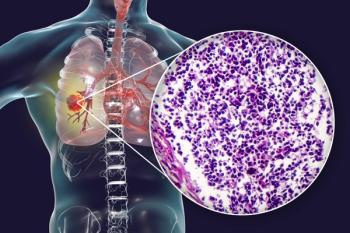
Monitoring Response to Radioligand Therapy in Prostate Cancer
Biochemical markers and advanced imaging modalities play a critical role in monitoring patients undergoing RLT therapy for metastatic prostate cancer.
The integration of radioligand therapy (RLT) into the prostate cancer treatment paradigm has brought forth a new era of targeted care, but with it comes the critical need for effective monitoring strategies to assess treatment efficacy.
Praful Ravi, MB, BChir, MRCP, provided a detailed look at the methods used to track patient response, emphasizing that a combination of biochemical and imaging markers is essential for a complete clinical picture, in an interview with CancerNetwork®. He highlighted prostate-specific antigen (PSA) as a cornerstone of this process, noting that a PSA decline, particularly within the first 2 cycles, is a strong prognostic indicator: a finding supported by data from the phase 3 VISION trial (NCT03511664).1
However, Ravi stressed that PSA alone may not be sufficient, as a small subset of patients could experience radiographic progression despite a decrease in PSA. Therefore, he advocates for the integral role of imaging, typically starting with a baseline (prostate-specific membrane antigen [PSMA])-PET scan. He recommends repeating imaging, such as a PSMA-PET or a CT and bone scan, after 2 or 3 cycles to capture any such progression. Additionally, Ravi discussed the increasing utility of SPECT imaging as a quick, supplementary tool to assess drug uptake after each dose.
While there are not yet clear-cut guidelines from major organizations like the Prostate Cancer Working Group 3 (PCWG3), NCCN, or ASCO, he notes that they generally advocate for a combination of PSA and some form of imaging.2-4 Ultimately, Ravi underscored that a multidisciplinary, multimodal approach is key to accurately evaluating patient response and ensuring the best possible outcomes in the context of this evolving treatment landscape.
Transcript:
That’s a good question because it can be heterogeneous. Typically, all patients are getting a PSA [test]. PSA is 1 of the most common biomarkers we use across the prostate cancer disease spectrum, [and] certainly in [patients receiving] radioligands. PSA is generally a good marker. An early decline in their PSA by week 12, within 2 cycles, [means] Lutetium-177 is prognostic. We know that from analysis of [the phase 3 VISION trial], as well as other work that's been included by [us]. PSA is generally a good biomarker.
Scans are also integral. Every patient does have a PSMA-PET [scan] done prior to starting RLT, so that's already there at baseline. I repeat imaging during therapy, at least after 2 or 3 cycles, whether that's with the PSMA-PET, if they have had 1 at baseline––which they have––or with CT and bone scan, which they might also have had. I generally advocate for imaging. The reason is that there are patients who may have radiographic progression in the absence of PSA progression. We know that from other agents and other trials and work that we have looked at as well. That's to capture that small number of patients who may have progression despite PSA decline.
There's also increasing use of SPECT-CT…and I am not a nuclear medicine physician, but I [think of] as a poor man's PET. It can be done quickly. It can be done within 4 to 24 hours after the dose of Lutetium-177 is given, and that images the uptake of the drug into the organs. Some institutions do this at every cycle. At Dana Farber, we do it at cycle 1 and at cycle 3. If I have a reassuring SPECT [scan] and a reassuring PSA decline and no clinical concerns, I do not necessarily gather further imaging beyond that. Sometimes we do. There are no clear-cut guidelines on this.
The [Prostate Cancer Working Group 3 [PCWG3], NCCN, and ASCO advocate for some imaging, typically with CT bone scans. If a patient had a PET scan, why do they also need a CT bone scan to follow? It just seems a bit redundant. There are new imaging guidelines upcoming through the PCWG3, so we will see what those say. Generally, it's a mix of PSA plus some imaging, whether that's SPECT, PET, or CT bone scan.
References
- Armstrong AJ, Sartor O, de Bono J, et al. Association of declining prostate-specific antigen levels with clinical outcomes in patients with metastatic castration-resistant prostate cancer receiving [177Lu]Lu-PSMA-617 in the phase 3 VISION trial. Eur Urol. 2024;86(6):552-562. doi:10.1016/j.eururo.2024.08.021
- Scher HI, Morris MJ, Stadler WM, et al. Trial design and objectives for castration-resistant prostate cancer: updated recommendations from the Prostate Cancer Clinical Trials Working Group 3. J Clin Oncol. 2016;22(34):1402-1418. doi:10.1200/JCO.2015.64.2702
- NCCN. Clinical Practice Guidelines in Oncology. Prostate cancer, version 2.2026. Accessed September 24, 2015. https://tinyurl.com/5fv56m4e
- Garje R, Riaz IB, Nagvi SA, et al. Systemic therapy in patients with metastatic castration-resistant prostate cancer: ASCO guideline update. J Clin Oncol. 2025;43(20):2311-2334. doi:10.1200/JCO-25-00007
Newsletter
Stay up to date on recent advances in the multidisciplinary approach to cancer.




















































































